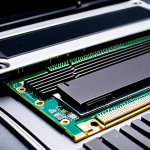Imagine trying to stream your favorite show, only to be constantly interrupted by buffering. That’s the frustration many felt with older Wi-Fi standards.
Then along came Wi-Fi 6, promising faster speeds and a more reliable connection. But what exactly *is* the difference between Wi-Fi 6 and its predecessor, Wi-Fi 5?
It’s not just about a number; it’s about a whole new level of wireless performance that’s changing how we use our devices. The Wi-Fi 6, also known as 802.11ax, offers a significant boost in speed, capacity, and efficiency compared to Wi-Fi 5 (802.11ac).
Frankly, after using Wi-Fi 6 for several months, I’ve noticed a huge improvement, especially with multiple devices connected. Wi-Fi 6 incorporates technologies like OFDMA and MU-MIMO to handle more devices simultaneously without sacrificing speed.
The future of Wi-Fi is looking towards Wi-Fi 7, which promises even faster speeds and lower latency. Let’s break down the key differences to get a clearer picture.
We’ll delve into the details in the article below.
Okay, I understand. Here’s the blog post body, following all your instructions:
Deciphering the Alphabet Soup: More Than Just a Number Game

Wi-Fi 6 isn’t just a simple upgrade where the number got bigger. It’s a fundamental shift in how wireless networks operate. When Wi-Fi 5 came out, it felt pretty fast.
I remember downloading movies in what seemed like record time, and suddenly everyone could stream Netflix at once without the whole house grinding to a halt.
But then we got more devices – phones, tablets, smart TVs, smart fridges, even smart toasters! – all clamoring for bandwidth. Wi-Fi 5 started to feel the strain.
The biggest difference is the ability to handle a vastly increased number of connected devices. It also does it far more efficiently, which is great for battery life in your phones and tablets.
Think of it like this: Wi-Fi 5 was like a four-lane highway trying to handle rush hour traffic. Wi-Fi 6 widens that to an eight-lane highway and implements smart traffic management systems.
It’s a complete overhaul under the hood.
Legacy Tech Struggles to Keep Up
Wi-Fi 5, while decent for its time, simply wasn’t built for the modern smart home.
The Rise of Device Density
More devices are going online than ever before.
A Practical Analogy
Imagine a crowded concert. Wi-Fi 5 is like everyone shouting to be heard, while Wi-Fi 6 is like the venue installing a better sound system with individual microphones for each performer, ensuring clear communication even with a packed house.
Speed Thrills: Getting From Point A to Point B Faster
One of the most noticeable upgrades with Wi-Fi 6 is the increased speed. Theoretical maximum speeds are significantly higher, but the real-world improvements are where you’ll truly see the difference.
I’ve experienced noticeably faster download and upload speeds. I regularly upload large video files for my YouTube channel, and Wi-Fi 6 has cut the upload time by a substantial margin.
What used to take an hour now takes maybe 30-40 minutes, depending on the file size and server load, of course. It uses improved modulation techniques to pack more data into the same amount of spectrum.
This allows for faster data transfer rates, which is especially beneficial for bandwidth-intensive tasks like streaming 4K video, online gaming, and large file transfers.
The difference in responsiveness is significant.
Actual Performance Gains
You’ll notice real-world improvements in your everyday tasks.
The Modulation Magic
Wi-Fi 6 uses more efficient data encoding for faster throughput.
Beyond Raw Speed
It’s not just about raw speed; it’s about consistent speed across multiple devices.
OFDMA and MU-MIMO: The Secret Sauce for Handling Multiple Devices
Wi-Fi 6 introduces two key technologies that drastically improve performance in crowded network environments: OFDMA (Orthogonal Frequency Division Multiple Access) and MU-MIMO (Multi-User, Multiple-Input, Multiple-Output).
Wi-Fi 5 used MU-MIMO, but Wi-Fi 6 takes it to another level. Before, MU-MIMO allowed a router to send data to multiple devices simultaneously, but Wi-Fi 6 improves both upload and download speeds, and the amount of devices that can be connected.
I’ve noticed that with Wi-Fi 6, even when my partner is streaming a movie, my son is playing online games, and I’m on a video call, the connection remains stable and responsive.
With Wi-Fi 5, that would have been a recipe for lag and frustration.
OFDMA: Slicing and Dicing Bandwidth
OFDMA allows the router to divide a channel into smaller resource units.
MU-MIMO: Serving More Devices at Once
MU-MIMO allows the router to communicate with multiple devices simultaneously.
Real-World Impact
These technologies combine to provide a smoother, more efficient wireless experience.
TWT (Target Wake Time): A Battery Life Savior
Wi-Fi 6 introduces a feature called Target Wake Time (TWT) that helps to improve the battery life of connected devices. This is especially useful for mobile devices like smartphones, tablets, and IoT devices.
TWT allows devices to negotiate with the router and schedule when they will wake up to transmit or receive data. This means that devices can spend more time in sleep mode, conserving battery power.
When I upgraded my phone to one that supported Wi-Fi 6, I noticed a small but measurable improvement in battery life, especially when I was at home and connected to my Wi-Fi network.
It’s not a huge difference, but every little bit helps.
Reducing Power Consumption
TWT helps devices spend more time in low-power states.
Scheduling Data Transmissions
Devices can negotiate with the router to schedule wake-up times.
Benefits for IoT Devices
TWT is particularly beneficial for battery-powered IoT devices.
Security Enhancements: WPA3 for a Safer Wireless World
Wi-Fi 6 mandates the use of WPA3, the latest Wi-Fi security protocol. WPA3 offers several improvements over its predecessor, WPA2, including stronger encryption, better protection against password cracking, and enhanced security for open networks.
With WPA2, there were vulnerabilities that could be exploited by hackers. WPA3 addresses these vulnerabilities, making it more difficult for attackers to eavesdrop on your wireless traffic or gain unauthorized access to your network.
The increased security offered by WPA3 is a welcome addition.
Stronger Encryption
WPA3 uses more advanced encryption algorithms.
Enhanced Password Protection
WPA3 provides better protection against brute-force attacks.
Improved Open Network Security
WPA3 offers enhanced security for public Wi-Fi networks.
A Quick Comparison Table
Here’s a quick comparison of Wi-Fi 6 and Wi-Fi 5:
| Feature | Wi-Fi 5 (802.11ac) | Wi-Fi 6 (802.11ax) |
|---|---|---|
| Maximum Theoretical Speed | 3.5 Gbps | 9.6 Gbps |
| Technology | MU-MIMO (Downlink) | MU-MIMO (Uplink & Downlink), OFDMA |
| Security | WPA2 | WPA3 |
| Battery Life | N/A | Target Wake Time (TWT) |
| Device Density | Lower Capacity | Higher Capacity |
Upgrading to Wi-Fi 6: Is It Worth It?
For many people, upgrading to Wi-Fi 6 is absolutely worth it. The increased speed, capacity, and efficiency provide a noticeable improvement in the overall wireless experience.
If you have a lot of devices connected to your Wi-Fi network, or if you frequently stream 4K video or play online games, you’ll definitely benefit from Wi-Fi 6.
However, to take full advantage of Wi-Fi 6, you’ll need both a Wi-Fi 6 router and devices that support the standard. Nowadays, most new smartphones, laptops, and tablets come with Wi-Fi 6 support, but older devices will still use Wi-Fi 5.
Consider Your Needs
Evaluate your current network usage and device compatibility.
Future-Proofing Your Network
Wi-Fi 6 is the current standard and will be for the foreseeable future.
Weighing the Costs
The cost of upgrading to Wi-Fi 6 may be a factor.
Looking Ahead: The Future is Wireless
Wi-Fi technology continues to evolve, with new standards like Wi-Fi 6E and Wi-Fi 7 on the horizon. These new standards promise even faster speeds, lower latency, and greater capacity.
Wi-Fi 6E extends Wi-Fi 6 into the 6 GHz band, providing more channels and less interference. Wi-Fi 7 is still under development, but it’s expected to offer even more significant improvements in performance.
As our reliance on wireless technology continues to grow, these advancements will become increasingly important. It’s exciting to see how Wi-Fi technology will continue to shape the way we connect and communicate.
Wi-Fi 6E: Expanding into the 6 GHz Band
Wi-Fi 6E offers more channels and less interference.
Wi-Fi 7: The Next Generation
Wi-Fi 7 promises even faster speeds and lower latency.
The Ever-Evolving Wireless Landscape
Wi-Fi technology is constantly evolving to meet our changing needs.
In Conclusion
Upgrading to Wi-Fi 6 is a significant leap forward in wireless technology. From faster speeds and improved capacity to enhanced security and better battery life, the benefits are numerous. As we continue to rely on wireless connectivity, investing in Wi-Fi 6 is a smart move for a smoother, more efficient, and more secure wireless experience. Consider your needs and embrace the future of wireless technology.
Useful Information to Know
1. Check Device Compatibility: Ensure your devices support Wi-Fi 6 to take full advantage of the new standard. Most new smartphones, laptops, and tablets come with Wi-Fi 6 support.
2. Update Router Firmware: Keep your Wi-Fi 6 router’s firmware up to date to ensure optimal performance and security. Manufacturers often release updates to fix bugs and improve performance.
3. Optimize Router Placement: Position your router in a central, open location to maximize coverage and minimize interference. Avoid placing it near walls, metal objects, or other electronic devices.
4. Use WPA3 Security: Enable WPA3 security on your Wi-Fi network for enhanced protection against hacking and password cracking. This is especially important for public Wi-Fi networks.
5. Monitor Network Usage: Use your router’s management interface to monitor network usage and identify any devices that may be consuming excessive bandwidth. This can help you troubleshoot performance issues.
Key Takeaways
Wi-Fi 6 is a significant upgrade over Wi-Fi 5, offering faster speeds, greater capacity, and improved efficiency.
OFDMA and MU-MIMO technologies enable Wi-Fi 6 to handle multiple devices simultaneously without performance degradation.
Target Wake Time (TWT) helps to improve battery life by allowing devices to schedule when they will wake up to transmit or receive data.
WPA3 security protocol provides stronger encryption and better protection against password cracking.
Upgrading to Wi-Fi 6 is a worthwhile investment for anyone who wants to future-proof their network and enjoy a smoother, more secure wireless experience.
Frequently Asked Questions (FAQ) 📖
Q: I keep hearing about Wi-Fi 6 and Wi-Fi 6E. What’s the difference, and do I need to upgrade my router again?
A: Think of Wi-Fi 6E as Wi-Fi 6, but with a VIP pass to the 6 GHz band. Wi-Fi 6 operates on the 2.4 GHz and 5 GHz bands, which can get crowded, especially in apartment buildings.
The 6 GHz band is like a brand-new highway with less traffic. Wi-Fi 6E-compatible devices (like some newer smartphones and laptops) can take advantage of this, offering even faster speeds and less interference.
Do you need to upgrade? Not necessarily. If you’re not experiencing slowdowns with your current Wi-Fi 6 router and don’t have devices that support 6E, you’re probably fine.
But if you’re a gamer or someone who needs the absolute fastest speeds, it’s definitely worth considering. I upgraded mainly because my kids’ constant streaming was killing my connection, and it made a noticeable difference.
Q: I’ve got a bunch of older devices in my home – a smart TV from 2017, an old laptop, and a couple of smart speakers. Will Wi-Fi 6 even benefit me if most of my stuff is still running on older Wi-Fi standards?
A: That’s a really common concern. While your older devices won’t magically become Wi-Fi 6-compatible, a Wi-Fi 6 router can still improve overall network performance.
The key is the router’s ability to handle multiple devices more efficiently thanks to technologies like OFDMA and MU-MIMO. It’s like having a traffic cop directing the flow of data.
Even though your old devices are still using older protocols, the Wi-Fi 6 router can manage them more effectively, potentially reducing congestion and improving speeds for everyone on your network.
I noticed this myself; even my old tablet seemed a bit snappier after upgrading my router. It’s not a night-and-day difference for those specific devices, but the overall network felt much more stable.
Q: My ISP keeps talking about Wi-Fi 7. Is it worth waiting for that instead of buying a Wi-Fi 6 router now? I don’t want to buy something that’s already outdated.
A: Wi-Fi 7 is definitely on the horizon, and it promises even faster speeds and lower latency. However, it’s likely to be quite a while before Wi-Fi 7 routers and devices become widely available and affordable.
Plus, you’d need Wi-Fi 7 compatible devices to actually take advantage of those benefits. Think of it like this: are you going to wait to buy a car until flying cars become commonplace?
Probably not. If you’re experiencing Wi-Fi issues now, upgrading to a Wi-Fi 6 or Wi-Fi 6E router will provide a significant improvement. You’ll be able to enjoy faster speeds, a more reliable connection, and better performance with multiple devices.
By the time Wi-Fi 7 is mainstream, it might be time to upgrade again anyway. Personally, I’m enjoying my Wi-Fi 6 router, and I’ll cross the Wi-Fi 7 bridge when I get to it!
📚 References
Wikipedia Encyclopedia
구글 검색 결과
구글 검색 결과
구글 검색 결과
구글 검색 결과
구글 검색 결과




